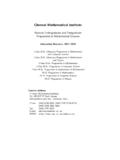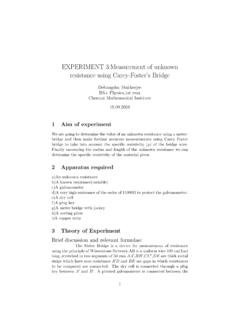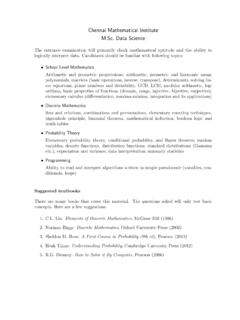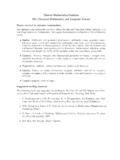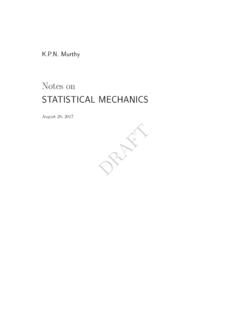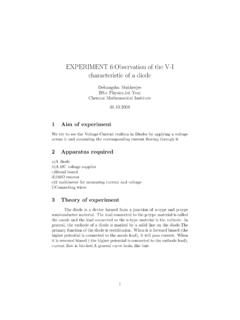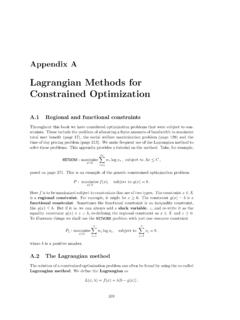Transcription of EXPERIMENT 1:Determination of Young’s modulus (η)of a ...
1 EXPERIMENT 1:Determination of Young smodulus ( )of a given springDebangshu Physics,1st yearChennai mathematical Aim of experimentWe are going to determine the Young s modulus of the material of a springby recording its time period of oscillation when loaded by a certain Apparatus requireda)A stand with clampb)A spring of the given materialc)Weightsd)Screw gaugee)Stop watchf)Meter scale3 Theory of experimentWhen a spring is loaded with a certain mass,it oscillates in avertical , a spring of radius R is made out of a wire of mass hanging from the end be Mg exerts a couple tending totwist the wire on the direction of arrow as shown in is the numberof turns in the ,the torque is given by: = r4 2N lDepressionxof end B is R Hence,x=R 4 RN r4If ,fis the restoring force due to the wire, then = , equation of motion is given by.
2 M d2xdt2= r4 4N R3 xThis is a whereT=2 r2 4M N R3 So, = 4 2 MT2 4N R3r4 Time periods vary with varying is evident from the equation that,if weplot an M vs. T graph,we will get a straight line as, the ratioM/T2is ProcedureFirst , our aim is to measure the radius of the spring and use a screw gauge to measure it. After taking a number of readings,we take the mean which gives us the best , the lengthof the wire is measured with a meter-scale. On dividing the length by theradius, we get the number of , we fix our spring to a clamp andhang weights from it with the assumption that the weights are along induces an oscillation in the spring along the vertical plane.
3 Wetake a stopwatch and measure the time taken for completion of 20 oscillationsfrom which we deduce the time period(T) of oscillation. The weights areknown to us. Hence, making use of the formula we deduce a number ofreadings for the Young s modulus . The mean gives us the best value of theYoung s Table 1-Measuring radius of springAs , circular scale zero coincides with linear scale zero , there would not beany over-estimation or underestimation in circular linear scale reading 100 circular scale readings 1 mm1 circular scale reading(Least count) lenMean diaMean radL(mm)C(mm)(mm)(mm)(mm)
4 The Linear Scale the Circular Scale ReadingTotal length=L+C radius=mean Table 2-Measuring radius of wireHere again, the same arguments follow for the least count which comes outto be , the circular scale zero in 3 divisions to the right of linearscale zero .So, there is always an underestimation of (3 )mm= diaMean diaMean radL(mm)C(mm)(mm)(mm)(mm)(mm) Table 3-Measurement of time period (T) of 20 Measuring no. of turns of springLength of spring = cmDiameter of wire = mmNo. of turns(N)=Lengthof springDiameterof spring= '211 turns6 ResultSo, the Young s modulus = 109N/m27 Measurements of radius of wire/spring with screw gaugeand weights1)Some instrumental error comes if the linear scale zero does not co-incidewith the circular scale have been taken care of by adding/subtractingthe )The wire may not be uniform throughout.
5 So,readings are taken at differ-ent points along the wire. Their mean gives us the best )While keeping the weights, we have assumed that the weight lies along theaxis of the spring. This assumption is strictly not correct. Strictly speakingit is some component of the Measuring time period (T)1)Firstly, the measurement of time period is not very accurate due to per-sonal observation )The weight was not strictly oscillating in a vertical plane but also oscil-4lated in the horizontal direction by a very small )We have actually measured the time period (T) of 20 oscillations and thendivided it by 20 to find the mean value of T.
6 However, the oscialltions takesplace in air and some damping effect is surely prevalent. Hence, the timeperiod (T) is not Error analysisFrom the equation of Young s modulus , we can say:d =dMM+ 2 dTT+ 3 dRR+ 2 drr(1)Here,dM=1 gm,dT= ,dR= ,dr= ,M=2062 gm,T= ,R= ,r= the values in (1), we get,d = (2)So, percentage error =d 100 = , corrected reading = (94 5) 109N/m25
